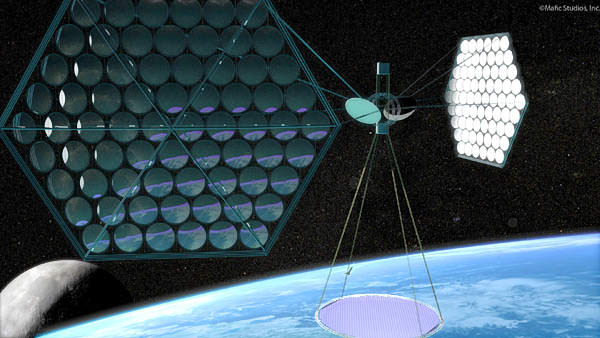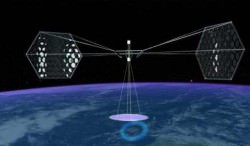

Solar Collecting Satellite. Image courtesy of Mafic Studios.
[/caption]
Is space-based solar power (SBSP) a technology whose time has come? The concept and even some of the hardware for harnessing energy from the sun with orbiting solar arrays has been around for some time. But the biggest challenge for making the concept a reality, says entrepreneur Peter Sage of Space Energy, Inc., is that SBSP has never been commercially viable. But that could be changing. Space Energy, Inc. has assembled an impressive team of scientists, engineers and business people, putting together what Sage calls “a rock-solid commercial platform” for their company. And given the current looming issues of growing energy needs and climate change, Space Energy, Inc. could be in the right place at the right time.
“Although it’s a very grandiose vision, it makes total sense,” Sage told Universe Today. “This is an inevitable technology; it’s going to happen. If we can put solar panels in space where the sun shines 24 hours a day, if we have a safe way of transmitting the energy to Earth and broadcasting it anywhere, that is a serious game changer.” If everything falls into place for this company, they could be producing commercially available SBSP within a decade.
The basic concept of SBSP is having solar cells in space collecting energy from sun, then converting the energy into a low intensity microwave beam, sending it down to Earth where it is collected on a rectenna, and then fed into the power grid to provide electricity. Almost 200 million gigawatts of solar energy is beamed towards the Earth every second, which is more energy than our civilization has used since the dawn of the electrical age. We only need a way to harness that energy and make it usable.
Space Energy, Inc.’s vision is to help create an energy-independent world, and improve the lives of millions of people by bringing a source of safe, clean energy to the planet from space. They are looking to become the world’s leading, and perhaps the first, SBSP enterprise.


Currently, there are times in the US when electricity is sold wholesale for close to a dollar a kilowatt during peak usage or times of emergency when power needs to be shipped around the national grid. Sage said SBSP will never be cost comparable with the current going rate of 6 or 7 cents a kilowatt due to the enormous set-up costs.
“We believe we can get it to a reasonable price, a fair market price as the demand for energy increases,” Sage said.
A huge energy gap is looming for our world, and that too, will change the energy game.
According to a white paper written by aerospace engineer James Michael Snead, “The End of Easy Energy and What Are We Going To Do About It,” in order to meet the world’s projected increase in energy needs by 2100 which likely will be at least three times what is being produced today, today’s sustainable energy production must expand by a factor of over 25. Under that scenario, even if the US were to build 70 new nuclear plants, add the equivalent of 15 more Hoover Dams, expand the geothermal capacity by 50 times what it is today, install over a million large land or sea wind turbines covering 150,000 square miles, build 60,000 square miles of commercial solar voltaic farms, and on top of that convert 1.3 billion dry tons of food mass to bio fuels, still only 30% of the power needs would be filled by 2100, or perhaps even earlier.
“Looking at every single technology we can as a civilization to try and fill the energy gap in a clean and resourceful, sustainable way, technologies like SBSP have to be made to work,” said Sage.
The first phase of Space Energy, Inc.’s plan is to launch a small prototype satellite into low Earth orbit. “This will help validate the numbers we are speculating on at this point, but also validate several different aspects of what SBSP can do,” said Sage. “From a successful demonstration, we are hoping to close power purchase agreements with one of several entities we are in discussions with at present. And on the strength of that we should be able to put the first commercial satellite in orbit.”
With regards to the timetable, Sage was hesitant to commit to a schedule. “As timetables go, everything needs to be flexible, but we are looking to close the financing for the demonstrator during the first quarter of this year (2009). The demonstrator is a 24 to 36 month project and, from there, we will start the commercial build-out of the main satellite, which could take up to four years to be operational.”
What are the biggest hurdles to overcome in this project? “If you would have asked me that question a few months ago,” Sage replied, “I would have said a combination of meeting the right people who could understand the vision and scope of what it is what we’re doing, and raising the initial financing for the demonstrator. Those hurdles, at this point, really seem to be taken care of. The more we have our technical teams talk with investors, the more people understand that we’re real and this isn’t some sort of Star Trek giggle factor. Right now, with the level of due diligence that’s been done not only on SBSP itself, but with ourselves as a commercially viable entity, we’re on the forefront of many people’s agenda in terms of how to move this forward. We see a straight path to making this a reality.”
Sage said no new technology is needed for the demonstrator, which will be a working, small prototype, but challenges do remain to move forward beyond that. “Obviously, there are technical challenges because something of this scale has never been done before. We know we can do wireless power transmission, as NASA did some pretty significant tests on this in the 1970s. We know the physics of wireless power transmission, and how everything should work from geostationary orbit.”
While the demonstrator won’t be of any scale where energy could be sold commercially, it would be a proof of concept.
“Once we’ve demonstrated that we can wirelessly beam power accurately to the ground in a safe, controlled, effective manner, and in a way that can be metered and measured,” said Sage, “we will have taken a massive step forward to prove that SBSP is a technology of the future that has the potential to really fill a gap in the world’s energy needs.”
Some have equated developing SBSP to what was accomplished with the Apollo program.
“There are so many positive spinoffs to SBSP as a game changing foundation of space commerce, that just by addressing a lot of the challenges that lay ahead, we will be blazing a trail for many other opportunities for a low earth orbit economy,” Sage added.
Space Energy, Inc. recently attended the World Future Energy Summit and has been overwhelmed with the response.
“We’ve had discussions with many different entities, both governmental and private, in the Middle East; Abu Dhabi, United Arab Emirates, Jordan, Dubai, many areas around Europe, and many of the world’s top investment firms. I don’t think we’re going to be short of people that will want to support us.” Sage added that in general, SBSP has strong support in Washington DC, and that SBSP recently was added to a list of technologies being studied by the Obama administration.
SBSP has ability to literally change the course of history, and impact the quality of life for people everywhere. Sage said this project is an entrepreneurs’ dream.
“I speak for our entire team here, we’re not just focused on how much money are we going to make,” Sage said. “We’re focused on the fact that this is an inevitable technology and someone is going to do it. Right now we’re the best shot. We’re also focused on the fact that, according to every scenario we’ve analyzed, the world needs space based solar power, and it needs it soon, as well as the up-scaling of just about every other source of renewable energy that we can get our hands on.”
“Space based solar power will happen whether we crack cold fusion, or whether we suddenly go to 80% efficiency on ground based solar power (currently its only at 50%),” Sage continued. “It has to happen based on the nature on what it is. With that in mind, I’ve been willing to put everything I have on the line to be able to make this work, and that was three years, ago. To see how far we’ve come in the past six to eight months has been amazing.”
“This is going to happen.”
For more information:
Space Energy, Inc.
Space Energy, Inc.’s interactive flash presentation
Video presentation on Space Based Solar Power by Mafic Studios
Could a new, fifth force of nature provide some answers to our biggest questions about…
In 2015, the United Nations adopted the 2030 Agenda for Sustainable Development—the Sustainable Development Goals…
Astronomers have been battling threats to their clear skies on all fronts lately. One of…
If you were Captain of the first USS Enterprise, where would you go!? Humanity is…
Now is the best time to observe Mars in 2025. Mars from 2014. Credit: Paul…
Scheduled for launch in 2027, the Nancy Grace Roman Telescope is slowly being readied for…